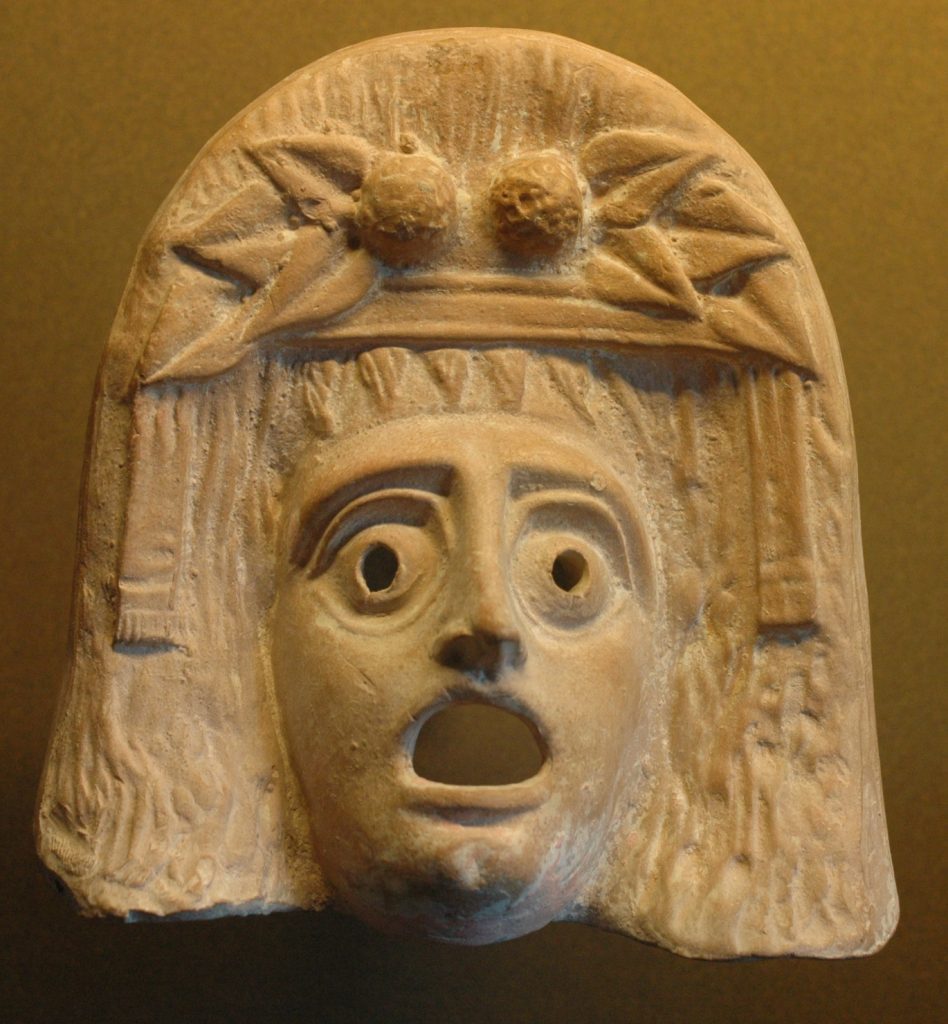The mask of Tragedy
07.27.2018
Figurine en terre cuite d'un masque de théâtre représentant Dionysos, datant du 1er ou 2ème siècle av. J.C. et excavé à Myrina Musée du Louvre (© base Atlas)
Who is this wide-eyed mask of tragedy of Antiquity with its arched eyebrows, frizzy hair frozen in mimicry, garish colours and an enormous opening for a mouth? A character but who? That of person on the threshold of the abyss. He is a warning!
The masks used in tragedies in ancient Athenian antiquity go back to the 6th century BC to Thespis, an author and renowned actor of his age. He, or his pupil Phrynicos, have been attributed with starting the tradition of pulling faces when acting which turned into the manufacture and wearing of masks. They were used in all the great tragedies written in the following century (that are still acted today) by the great masters Aeschylus (525-456), Sophocles (496-406) and Euripides (485-406).
They were made from plant material, linen, wood, wax or leather. During the many centuries of Hellenic, Hellenistic and then Roman culture that followed, these theatre masks continued to be used and to evolve. But they never missed the call of the actor’s role play. Only terracotta reproductions have remained.
The Romans used the word persona to describe these masks which reveals their function in ancient theatre. The verb personare (literally: to resonate) means to reverberate, to ring on all sides, to carry the voice. Persona nods to these masks as having huge gaping mouths probably to carry the actor’s voice as far as possible into the stands.
And the mask could be identified from far off because it had the features of a known archetype with criteria recognised by all (length of hair and beard, colours amongst other signs), hence the noble by birth, the master, the warrior, the servant, the slave, the old man, the youth, the mother, the adolescent girl etc. And certain exaggerated projections on these masks nodded to the nature of a character or a psychological trait such as nobility of spirit, good humour, an angry disposition, vanity etc.
These masks could therefore be used in all plays, they were not the personification of an individual but of a character type that everyone had met or could become with the exception of some individual masks (Œdipus with his tired eyes, the Minotaur, a God or deity…). The mask had meaning for all… or simply put, this persona was no-one in particular and a little bit of everyone at the same time.
Great philosopher Cornelius Castoriadis brilliantly explains the meaning of tragic theatre by dismissing the common expression of “Greek tragedies” as false: tragedy is from Athens, born in an ancient democratic city subjected to philosophical questions about the limits of human action in the face of divine decrees.
For the Greeks had no single God, no sacred books, no prophets, no notion of sin imposed by Christianity. Their mythological Gods carry out their dealings between themselves and with human beings whom they punish severely if they are wronged or if their preferences are violated in the process. But the men who follow their own rules, as in a democracy, can then come into conflict with divine prerogatives. But where is the line beyond which they must not cross? The line is the threshold where human action, carried away by its passions, gives into excess. Go past this point and you reach “hubris”, an excess of humour or exaggerated self-pride that leads man to overstep sacred laws, question those of the City, despise reason and violate the laws of destiny set by the Gods…
Tragedy is putting this pride on stage and showing a being who dares to demand more from destiny than the part afforded to him or her. This theatre thus had an edifying role to play for members of the public. It taught moral reflection. And the mask worn by the actor addressed each person in the audience individually, it was grimacing warning.
Persona is therefore this mask via which a voice is carried and which brings us back in line. The ambiguity in French means that it is not a person but concerns everyone… During the 20th century, psychiatrist and philosopher Carl Gustav Jung had persona designate a social figure, the identity of which existed only in the reflection created in the eye looking at it. But it is only in the 21st century, after several millennia of plays that science has perfected the only real mask to go the distance, one that removes the old face to reveal the real face lying beneath: the beauty mask!

